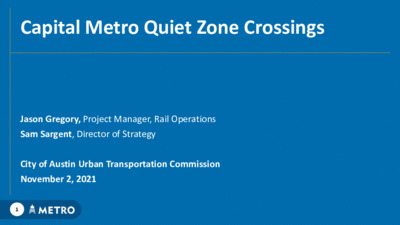Backup — original pdf
Backup

Capital Metro Quiet Zone Crossings Jason Gregory, Project Manager, Rail Operations Sam Sargent, Director of Strategy City of Austin Urban Transportation Commission November 2, 2021 1 Capital Metro Rail Operations RED LINE MAP • 162 miles of total track, freight and commuter operations • 32 miles of MetroRail Red Line commuter rail service • 10 MetroRail vehicles, 9 Red Line stations • 25 miles of future Green Line service, 10 stations 2 What is a Quiet Zone Crossing • Freight and Commuter Engineers are required to sound the horn in advance of all crossings UNLESS there is an approved quiet zone in place. • A quiet zone is usually requested through the railroad from various municipalities (i.e. cities, neighborhood associations, etc.). 3 What is a Quiet Zone Crossing • A thorough approval process is followed in order to establish a quiet zone. Railroad officials as well as State and Federal authorities, called a Diagnostic Review Committee, establish what is needed at the crossings to deem them safe for quiet zone status. • Quiet zones are periodically reviewed to ascertain whether the current configuration is still valid to maintain quiet zone status. • Internal audits are also performed to verify quiet zone crossing integrity. 4 What is a Quiet Zone Crossing • Quiet zone crossings must adhere to federal regulations that are stringent in order to maintain safety. • Quiet zone crossings must have sufficient safety measures included using either: • Supplemental Safety Measures (SSMs) – Methods such as 4 quadrant gates, channelization efforts such as medians or delineators. • Alternative Safety Measures (ASMs) – Enforcement programs or other engineering efforts. 5 What is a Quiet Zone Crossing • Engineers can and will still blow the horns if dangers at the crossing are evident, such as trespassers, cars blocking the crossing or workers and equipment near the Right Of Way. 6 How Are Quiet Zone Crossings Funded? Quiet Zone crossings are funded through: • Capital Project funds (Capital Metro) • Federal Grants • Local government funds, in some cases 7 Quiet Zone Crossings in the Austin Metro Area Austin, Cedar Park and Leander comprise the Capital Metro commuter line. There are 86 crossings in the commuter Central Subdivision. All of them are official quiet zone crossings with the exception of: • Rundberg Lane • Rutland Drive • Braker Lane • Kramer Lane • McNeil (Round Rock) • Pleasant Valley Road 8 Questions? Thank You. Jason Gregory, Project Manager, Rail Operations Sam Sargent, Director of Strategy City of Austin Urban Transportation Commission November 2, 2021 9